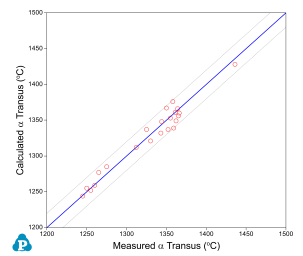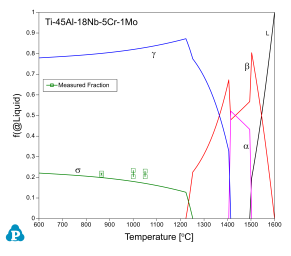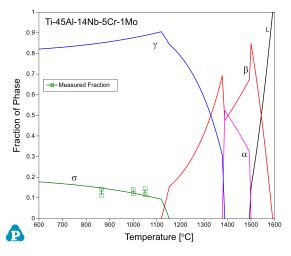Thermodynamic Database
Components (16)
A total of 16 components are included in PanTiAl database as listed here:
Major alloying elements: Al, Cr, Mo, Nb, Ta, Ti, V, W and Zr
Minor alloying elements: B, C, Mn, N, O, Si and Sn.
Suggested Composition Range
The suggested composition range for each element is listed in Table 1. It should be noted that this given composition range is rather conservative. It is derived from the chemistries of the multicomponent commercial alloys that have been used to validate the current database. In the subsystems, many of these elements can be applied to a much wider composition range. In fact, some subsystems are valid in the entire composition range as given in Section Key Elements and Subsystems
| Elements | Composition Range (wt.%) |
|---|---|
|
Ti |
50-100 |
|
Al,Mo,Nb |
0-30 |
|
Cr,Ta,V,W,Zr |
0-10 |
|
B, C, N, O, Mn, Si, Sn |
0-0.5 |
Phases
A total of 208 phases are included in the current database. The names and thermodynamic models of some phases are given in Table 2. Information on all the other phases is listed in PanTiAl2024: List of Phases. Users can also view it through TDB viewer of Pandat™.
Key Elements and Subsystems
This database is designed for TiAl based alloy applications. A total of 117 subsystems, including 110 binary and 7 ternary subsystems have been assessed. The modeling status is indicated by numbers. The systems with number 10 are fully assessed in the whole composition range. The higher value shows higher reliability of the system.
Binary Systems (110)
| Al-B(10) | Al-C(10) | Al-Cr(10) | Al-Mn(10) | Al-Mo(10) | Al-Nb(10) |
| Al-O(10) | Al-Si(10) | Al-Sn(10) | Al-Ta(10) | Al-Ti(10) | Al-V(10) |
| Al-W(10) | Al-Zr(10) | B-C(10) | B-Cr(10) | B-Mn(10) | B-Mo(10) |
| B-Nb(10) | B-Si(10) | B-Sn(10) | B-Ta(10) | B-Ti(10) | B-V(10) |
| B-W(10) | B-Zr(10) | C-Cr(10) | C-Mn(10) | C-Mo(10) | C-Nb(10) |
| C-Si(10) | C-Ta(10) | C-Ti(10) | C-V(10) | C-W(10) | C-Zr(10) |
| Cr-Mn(10) | Cr-Mo(10) | Cr-N(10) | Cr-Nb(10) | Cr-O(10) | Cr-Si(10) |
| Cr-Sn(10) | Cr-Ta(10) | Cr-Ti(10) | Cr-V(10) | Cr-W(10) | Cr-Zr(10) |
| Mn-Mo(10) | Mn-Nb(10) | Mn-Ni(10) | Mn-O(10) | Mn-Si(10) | Mn-Sn(10) |
| Mn-Ta(10) | Mn-Ti(10) | Mn-V(10) | Mn-Zr(10) | Mo-Nb(10) | Mo-O(10) |
| Mo-Si(10) | Mo-Sn(10) | Mo-Ta(10) | Mo-Ti(10) | Mo-V(10) | Mo-Zr(10) |
| Nb-O(10) | Nb-Si(10) | Nb-Sn(10) | Nb-Ti(10) | Nb-V(10) | Nb-W(10) |
| Nb-Zr(10) | O-Si(10) | O-Sn(10) | O-W(10) | O-Zr(10) | Si-Sn(10) |
| Si-Ta(10) | Si-Ti(10) | Si-V(10) | Si-W(10) | Si-Zr(10) | Sn-Ta(10) |
| Sn-Ti(10) | Sn-V(10) | Sn-Zr(10) | Ta-Ti(10) | Ta-V(10) | Ta-W(10) |
| Ta-Zr(10) | Ti-V(10) | Ti-W(10) | Ti-Zr(10) | V-W(10) | V-Zr(10) |
| W-Zr(10) | Al-N(8) | Mo-N(8) | N-Nb(8) | N-Si(8) | N-Sn(8) |
| N-Ta(8) | N-Ti(8) | N-V(8) | N-Zr(8) | O-Ta(8) | O-Ti(8) |
| O-V(8) | Mn-N(6) |
Ternary Systems (7)
| Al-Ti-V(10) | Al-Cr-Ti(8) | Al-Mn-Ti(8) | Al-Mo-Ti(8) | Al-Nb-Ti(8) | Al-Si-Ti(8) |
| Al-Ti-W(8) |
Database Validation
PanTiAl database focuses on γ-TiAl-based alloys systems. It is very important to get accurate α transus (α→γ) temperatures. Table 3 compares the calculated α transus temperatures with the experimental data for various alloys [1992Lom, 1993Fuc, 1995Bho, 1995Fuc, 1995Kim, 2014Pen], which is also shown in Figure 1.
Figure 1: Comparison between calculated and measured α transus temperatures [1992Lom, 1993Fuc, 1995Bho, 1995Fuc, 1995Kim, 2014Pen]
Schwaighofer et al. [2014Sch] investigated microstructure and phase evolution of a β-solidifying TNM alloy with a nominal composition of Ti-42.82Al-4.05Nb-1.01Mo-0.11B (in at.%) with minor C and Si (C+Si ≤ 1at.%) by means of uniaxial compressive hot-deformation tests. They carried out in situ high energy X-ray diffraction (HEXRD) experiments to obtain a deeper insight about the deformation behavior of the alloy, i.e. phase fractions and texture evolution during isothermal and non-isothermal compression. Figure 2 shows the comparison between the calculated phase fractions under equilibrium condition and those determined by in situ HEXRD method. The exact contents of C and Si are not mentioned in the reference [2014Sch], so they are not included in the calculation. The calculated results are in reasonable agreement with the experimental data [2014Sch] for the β, α, and γ phases. The α2 phase starts to form at ~1200 °C, which is higher than 1160 °C for a typical TNM alloy. Considering the stress applied to the sample, the hexagonal based structure of α2 phase is more favorable than the BCC-based structure of β0 phase.
Figure 2: Calculated phase fractions for alloy Ti-43Al-4Nb-1Mo-0.1B (in at.%) compared with experimental data [2014Sch]
Kesler [2011Kes] investigated the γ+σ microstructure in the Ti-Al-Nb-Cr-Mo system. The alloy samples were aged at elevated temperatures for 2 hours and then furnace cooled. The volume fractions of the σ phase were obtained by analyzing the SEM-BSE images. The measured fractions are compared with line calculations for these alloys (Ti-45Al-22Nb-5Cr, Ti-45Al-18Nb-5Cr-1Mo, and Ti-45Al-14Nb-5Cr-1Mo), as shown in Figure 3, Figure 4 and Figure 5, respectively. The calculated σ phase fractions slightly increase with decreasing temperatures while the measured values do not change very much at different temperatures, which may be due to the slow cooling rate after aging. The calculations are in reasonable agreement with the experimental data.
Figure 3: Calculated phase fractions for alloy Ti-45Al-22Nb-5Cr (in at.%) compared with experimental data [2011Kes]
Figure 4: Calculated phase fractions for alloy Ti-45Al-18Nb-5Cr-1Mo (in at.%) compared with experimental data [2011Kes]
Figure 5: Calculated phase fractions for alloy Ti-45Al-14Nb-5Cr-1Mo (in at.%) compared with experimental data [2011Kes]
[1992Lom] C. M. Lombard, R. M. Nekkanti and V. Seetharaman, Scripta Met., 26 (1992), 1559-1564.
[1993Fuc] G. E. Fuchs, Structural Intermetallics, eds. Darolia, R. et al., (Warrendale, OH: TMS, 1993), 195-203.
[1995Bho] G. E. Bhowal, W. A. Konkel and H. F. Merrick, Gamma Titanium Aluminides, eds. Y-W. Kim et al. (Warrendale, OH: TMS, 1995), 787-794.
[1995Fuc] G. E. Fuchs, Mat. Sci. Eng. A, A192/193 (1995), 707-715.
[1995Kim] Y-W. Kim, Mat. Sci. Eng. A, A192/193 (1995), 519-533.
[2011Kes] Michael Steiner Kesler, "Deformation and Fracture behavior of Ti-Al-Nb-(Cr,Mo) Alloys with a Microstructure at Ambient Temperature", Doctoral Dissertation, University of Florida 2011.
[2014Pen] Y. Peng, G. Wang, F. Chen, G. Chen, Materials Science & Technology, 22 (2014), 91-96.
[2014Sch] E. Schwaighofer, H. Clemens, J. Lindemann, A. Stark, S. Mayer, Materials Science and Engineering A, Structural Materials: Properties, Microstructure and Processing, 297-310.




